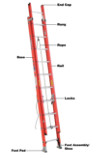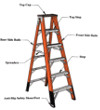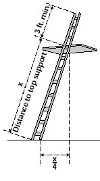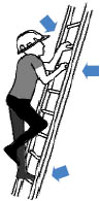Tailgate Safety Talks
Edited by Airton G. Kohls and Matt Cate (Source: NLTAPA Tailgate Safety Talks - Delaware LTAP)
With this edition of RoadTalk, we are starting a new series of articles that focus on workforce safety. The Training Resources Workgroup of the National LTAP Association has developed briefing packages to support local agencies with educational resources on various safety related topics.

Supervisors and crew leaders can distribute this printed information or simply get together with employees and discuss the information during a Tailgate Talk. They can be held weekly or monthly or in connection with a new activity or season. They are intended to be short and focused so that, over time and together with existing practices and policies, they help build a culture of safety within local agencies. The intent of this program is to provide supervisors with packages of materials, targeted towards a broad array of public works equipment and practices that will make it easy for them to carry out these important talks.

Ladder Safety
Dangers/Risks/Problems:
According to the Occupational Safety and Health Administration, OSHA, “falls from portable ladders (step, straight, combination and extension) are one of the leading causes of occupational fatalities and injuries.” Falls from ladders make up nearly a third of construction deaths. These deaths and injuries are preventable and falls can be prevented by following safe work practices. In public works (we are often employing ladders from less stable, unlevel areas, along with other challenges) good safety practices are essential.
Considerations to Mitigate Risk:
- Read the labels on the ladder - they will tell you a great deal about the ladder, its appropriate uses, and warnings you should heed.
- Inspect the ladder before each use. If it is damaged, don’t take the chance.
- If you are fatigued, dizzy, or have balance problems, avoid ladders.
- Avoid ladders in high winds or storms.
- Choose the right ladder material.
- Ladders are generally constructed of one of three materials - wood, aluminum, or fiberglass.
- Aluminum is the lightest material, but if you are working near power lines of any voltage, remember that aluminum is conductive and you run the risk of electrocution.
- Choose the right duty rating for you, your task, and your tools and materials.
- Choose the right length.
- A ladder can be too short, but it can also be too long.
- With a step ladder, standing on the top cap or the step below the top cap is unsafe due to the likelihood of losing your balance.
- With an extension ladder, the top three rungs are not for climbing.
- A ladder is too long if the ceiling height does not allow it to be set-up at the proper angle.
- An extension or straight ladder must extend at least 3 feet above the point of support. However, the portion above the point of contact can act as a lever to destabilize the footing, so care must be taken with dismounting the ladder onto the elevated surface and your feet should not be placed on rungs above the point of support.
- Check the Duty Rating of the ladder. The weight consists of the total of your weight, the weight of your clothing and protective equipment, and the weight of tools and supplies that you carry or are on the ladder.
- Proper footing. Use a ladder only on stable and level surfaces, unless it has been secured (top or bottom). Do not place a ladder on unstable bases to obtain additional height. Do not move or shift a ladder while a person or equipment is on the ladder.
- Ladders can be displaced by other work activities, so be mindful of the surroundings. If in doubt of what activities, equipment, or personnel may be moving about, secure the ladder to prevent displacement or erect a barricade to keep traffic away from the ladder. As a special case, be mindful not to place a ladder in front of a door that can be opened.
- The ladder should be angled such that the base is approximately one quarter of the working length from the object supporting it.
- Be sure that all locks and braces are in place.
- Watch out for overhead power lines in general but particularly with metal ladders. While on a ladder, even a low voltage shock can cause you to lose your footing on the ladder and fall.
- Always maintain a 3-point (two hands and a foot, or two feet and a hand) contact on the ladder when climbing. Keep your body near the middle of the step and always face the ladder while climbing. Climb slowly and deliberately and avoid sudden movements.
- Wear slip resistant boots/shoes and clean the soles to maximize traction.
- Use towlines or a tool belt to move materials up and down the ladder so that your hands are free for climbing.
- Do not overreach or lean while working; keep your weight centered on the ladder.
- Keep ladders free of any slippery material on the rungs or feet.
- One person at a time on ladders.


When is a Ladder a Poor Choice?
While a ladder or stepladder is commonly used to reach higher work areas, it may not always be the best option. Ask yourself:
- Will I have to hold heavy items while on the ladder?
- Is the elevated area so high that it would require a long ladder that could be unstable?
- Will I be working from this height for a long time?
- Do I have to stand on the ladder sideways in order to do this work?
If any of these are yes, maybe a ladder isn’t the best tool. If possible, bring in other equipment like a scissor lift or a boom/bucket lift.

Safety Videos:
The American Ladder Institute has very helpful, free videos (see link below) for stepladder safety, single and extension ladder safety, mobile ladder safety, and articulated ladder safety.
Safety Training:
The American Ladder Institute has free online training (see link below) for individuals or groups. These too are organized for stepladders, single and extension ladders, mobile ladders, and articulated ladders.
Resources for Further Reading:
OSHA Publications: https://www.osha.gov/pls/publications/publication.AthruZ?pType=AthruZ#L
American Ladder Institute (videos): http://www.americanladderinstitute.org/page/LSTVideos
American Ladder Institute (training): https://www.laddersafetytraining.org/
Back-Contents-Forward